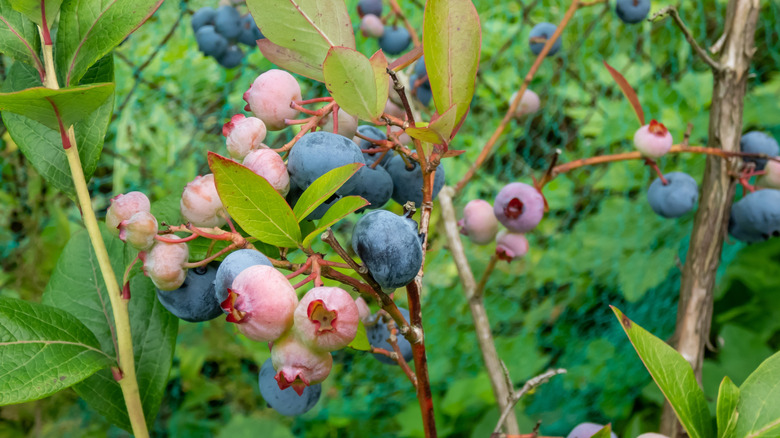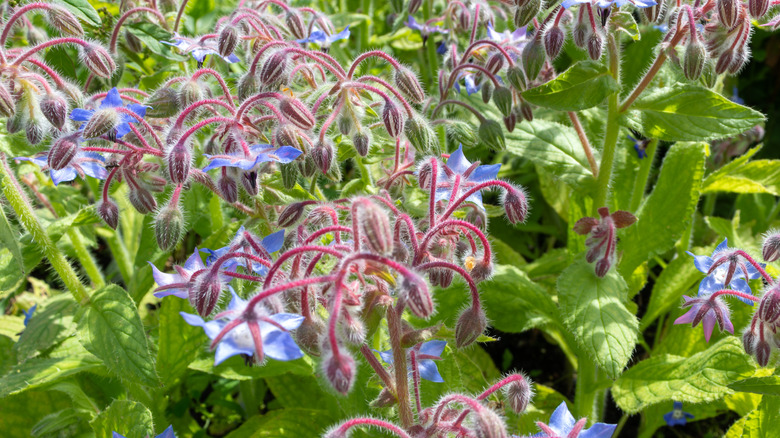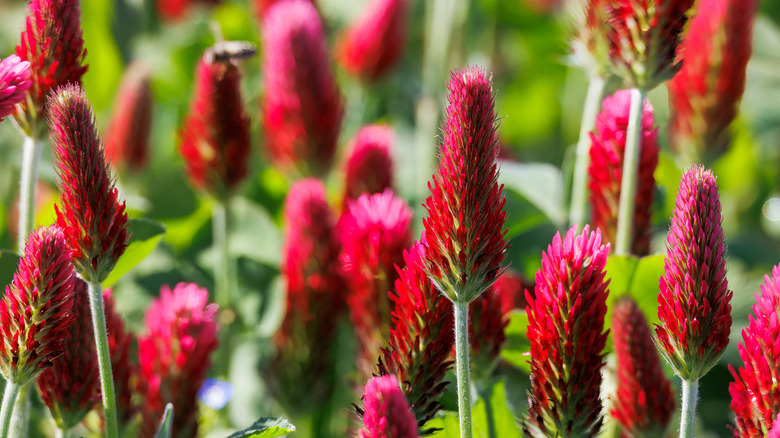Start Growing These Companion Herbs In The Garden Next To Your Blueberries
You may have heard of the practice of companion planting — certain plants, when located next to one another, may benefit each other by improving soil quality, deterring pests, or drawing in beneficial pollinators. A great illustration of this practice is the Indigenous agricultural practice of companion planting crops known as the Three Sisters method. This system features maize or corn, beans, and squash: Beans fix nitrogen in the soil, corn stalks provide structure for beans, and low-growing squash or pumpkins serve as natural weed prevention.
Even if your desired crop is a completely different plant type, finding appropriate garden companions can serve similar purposes. This can be especially true for blueberry plants — the most commonly grown of which is the highbush blueberry (Vaccinium corymbosum) — which already tend to deliver higher berry yields when grown next to other blueberry bush cultivars. By carefully selecting companion herbs, you may see benefits in terms of weed suppression, soil improvement, and pest prevention.
Companion plants that attract pollinators and deter pests
A few things to keep in mind when selecting friends for blueberries is that they must thrive in USDA Hardiness Zones 3 through 8 and at least tolerate acidic soil, as blueberries are best grown in soils with a pH of less than 6.0. Borage (Borago officinalis), an annual considered hardy in zones 2 through 11, is one of those unfussy herbs that can grow in just about any type of soil. With its edible leaves and lovely blue flowers, there are many ways to use borage, and it's a great choice of companion plant for many crops on account of its attractiveness to bees and butterflies. Additionally, while it may not drive off unwanted visitors on its own, it tends to bring in lacewings, hoverflies, and other predators of common garden pests. (Just keep in mind that, due to its self-seeding behavior, it may be considered invasive in some areas!)
Yarrow (Achillea millefolium) can be another good choice of companion for zones 3 through 9, thanks to ease of care, comfort with acidic soil, and tendency to draw in pollinators. If browsing deer and rabbits are an issue in your area, they'll probably steer clear of yarrow — as will pest insects such as mosquitos! Like borage, it can also be a bit of an aggressive spreader, but luckily, if it gets out of hand and you need to mow some of it down, it makes an excellent "green mulch" when chopped and dropped.
Companion plants to improve soil and suppress weeds
As illustrated by the Three Sisters practice, legumes are widely favored as cover crops — a sort of living mulch that can protect and nourish soil, as well as fix nitrogen — but it can be a touch difficult to find legumes that can flourish in acidic soil next to blueberries. However, clovers (yes, they are legumes!), such as crimson clover (Trifolium incarnatus) can be a good choice for acidic soil. Just keep in mind that it can become invasive if not managed and cut back regularly.
There are actually a few different reasons to grow crimson clover as a cover crop in zones 2 through 10: when alive, they are major pollinator attractors and can help prevent soil erosion. When mown down or winter-killed and tilled back into the soil, they pay dividends in terms of weed control and returning nitrogen to the soil. Try growing clover patches in rows between your blueberry bushes!
Another way companion plants can serve your blueberries is by out-competing invading weeds. Creeping thyme (Thymus serpyllum), hardy in zones 4 through 8, can serve as both an eye-catcher and a weed choker in your garden, and can tolerate a wide variety of soils, including slightly acidic. Its dense, low-growing habit can also help retain soil moisture.


